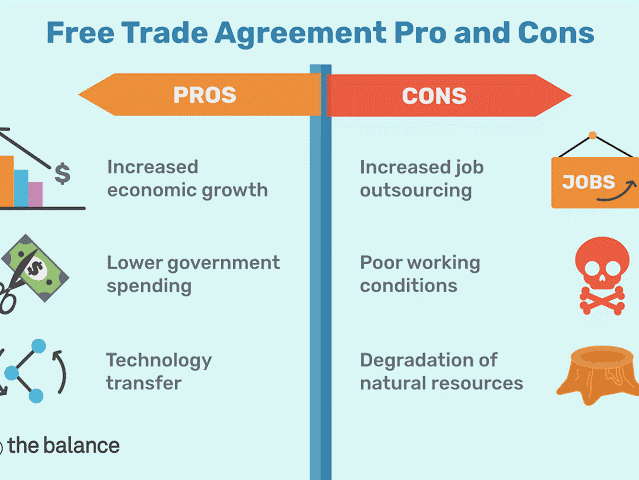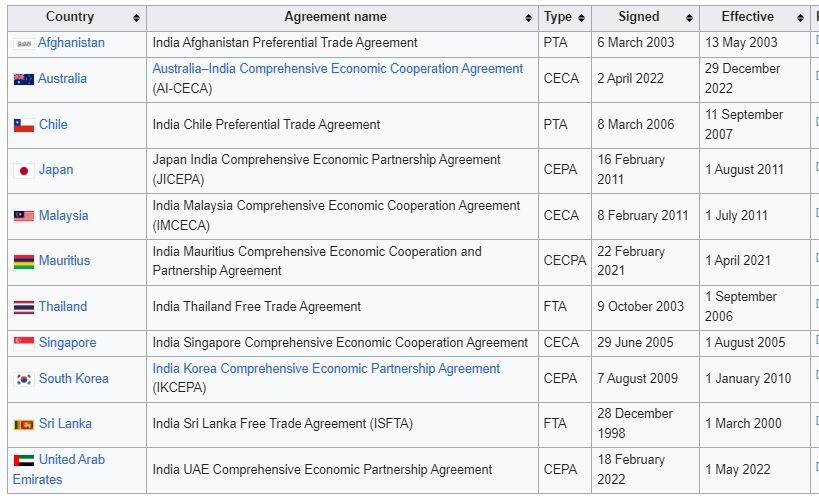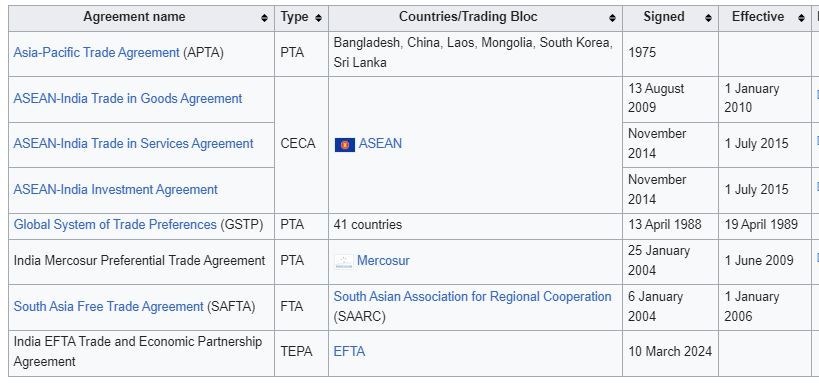Description
Daily Editorial Analysis
Editorial Analysis based on “Investment Lessons from the India-EFTA Trade Deal” which was published in The Hindu.
Introduction:
- India made a historic trade deal, in March, with the European Free Trade Association (EFTA), comprising Iceland, Liechtenstein, Norway, and Switzerland.
- The newly signed Trade and Economic Partnership Agreement (which we refer to as FTA) between India and EFTA is expected to give a much-needed leg-up to the low levels of extant trade between the two sides.
- The FTA between India and EFTA is also important because, India has agreed to include issues such as environment and labor, which it has traditionally opposed incorporating in trade agreements.
What Is a Free Trade Agreement (FTA)?
- A free trade agreement is a pact between two or more nations to reduce barriers to imports and exports among them. Under a free trade policy, goods and services can be bought and sold across international borders with little or no government tariffs, quotas, subsidies, or prohibitions to inhibit their exchange.
- The concept of free trade is the opposite of trade protectionism or economic isolationism.

Types of free trade agreements:
- Bilateral Free Trade Agreement (FTA):
- Bilateral FTAs involve trade agreements between two countries, aimed at reducing or eliminating tariffs, quotas, and other trade barriers between them. These agreements focus on enhancing trade and economic cooperation between the two signatory countries.
- Regional Free Trade Agreement (RFTA):
- Regional FTAs involve trade agreements between multiple countries within a specific region. These agreements aim to promote economic integration and cooperation among the member countries by reducing trade barriers and facilitating the flow of goods and services within the region. Examples include the European Union (EU), the North American Free Trade Agreement (NAFTA), and the Association of Southeast Asian Nations (ASEAN) Free Trade Area (AFTA).
- Multilateral Free Trade Agreement:
- Multilateral FTAs involve trade agreements between three or more countries, often covering a broader geographical area or multiple regions. These agreements aim to create a more open and interconnected global trading system by reducing trade barriers among participating countries. The most prominent example is the World Trade Organization (WTO) agreements, which include a wide range of trade issues and cover a large number of member countries.
- Preferential Trade Agreement (PTA):
- Preferential trade agreements are FTAs that offer preferential treatment to certain products or sectors from participating countries. These agreements may involve tariff reductions, quotas, or other trade concessions for specific goods or services traded between the signatory countries. PTAs are often used by developing countries to promote trade with more advanced economies.
- Comprehensive Economic Partnership Agreement (CEPA):
- CEPA is a type of FTA that goes beyond traditional trade agreements by also addressing broader economic issues such as investment, intellectual property rights, and regulatory cooperation. These agreements aim to deepen economic integration and promote long-term cooperation between the participating countries.
- Free Trade Area (FTA):
- A free trade area is a type of trade agreement that eliminates tariffs, quotas, and other trade barriers on goods and services traded between member countries. However, each member country maintains its own trade policies with non-member countries. FTAs focus on promoting trade and economic growth among member countries while allowing them to maintain their sovereignty in trade policy matters.
Bilateral Agreements of India:

Multilateral Agreements:

Way ahead for India’s free trade policy:
- Diversification of Trade Partners:
- India should focus on diversifying its trade partners to reduce dependency on a few markets and mitigate risks associated with trade disruptions. Currently, India's major trading partners include the United States, China, and the European Union. By expanding trade relations with countries in Africa, Latin America, and Southeast Asia, India can tap into new markets and opportunities for growth.
- Modernization and Upgradation of Existing FTAs:
- India has several existing FTAs with countries and regions such as ASEAN, Japan, South Korea, and the Gulf Cooperation Council (GCC). These agreements need to be modernized and upgraded to address emerging trade issues, promote greater market access for Indian exporters, and enhance trade facilitation measures. This could involve renegotiating certain provisions, reducing non-tariff barriers, etc.
- Focus on Services Sector and Digital Trade:
- India has a competitive advantage in the services sector, including IT services, software development, and business process outsourcing (BPO). Future FTAs should prioritize the liberalization of trade in services and facilitate the movement of skilled professionals across borders. Additionally, with the growing importance of digital trade, India should explore provisions related to e-commerce, data localization, and intellectual property rights in its trade agreements.
- Sustainable Development and Environmental Standards:
- As global awareness of environmental sustainability grows, future FTAs should incorporate provisions related to environmental protection, climate change mitigation, and sustainable development. India can negotiate agreements that promote responsible trade practices, encourage the adoption of green technologies, and ensure compliance with international environmental standards. This approach aligns with India's commitments under the Paris Agreement and its efforts to achieve sustainable development goals.
- Enhanced Connectivity and Infrastructure Development:
- Improving physical and digital connectivity with trading partners is essential for expanding India's trade networks and boosting economic growth. India should prioritize infrastructure development projects such as ports, roads, railways, and digital connectivity initiatives that facilitate trade flows and reduce transportation costs. Enhanced connectivity can also strengthen regional economic integration and foster closer ties with neighboring countries.
- Strengthening Domestic Manufacturing and Export Competitiveness:
- India should focus on strengthening its domestic manufacturing base and enhancing export competitiveness in key sectors such as automotive, pharmaceuticals, textiles, and electronics. This could involve implementing supportive policies such as production-linked incentives (PLIs), export promotion schemes, skill development programs, and technology upgradation initiatives. By boosting domestic manufacturing capabilities and improving product quality and standards, India can better capitalize on export opportunities in global markets.
- Coupling Trade and investment:
- Decoupling trade from investment is not a good idea.
- Combining the two would give India a clear negotiating leverage to strike a beneficial deal.
- For example, India can argue that it needs more concessions in trade in return for offering something on investment or vice-versa.
Must read:
https://www.iasgyan.in/daily-current-affairs/indias-trade-agreement-with-efta#:~:text=In%202023%2C%20India%20was%20the,trade%20volume%20of%20%2425%20billion.&text=The%20agreement%20has%20the%20potential,India%20and%20the%20EFTA%20countries.
Sources:
https://pib.gov.in/PressReleaseIframePage.aspx?PRID=2013169
https://www.iasgyan.in/daily-current-affairs/indias-trade-agreement-with-efta#:~:text=The%20agreement%20aims%20to%20lower,(FDI)%20to%20these%20sectors.







